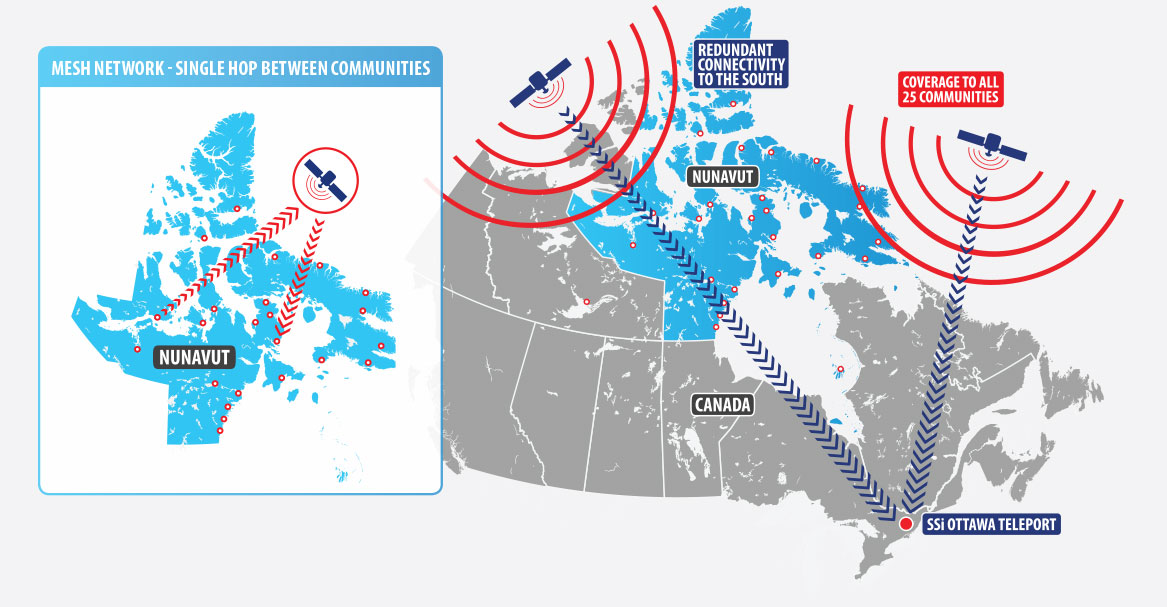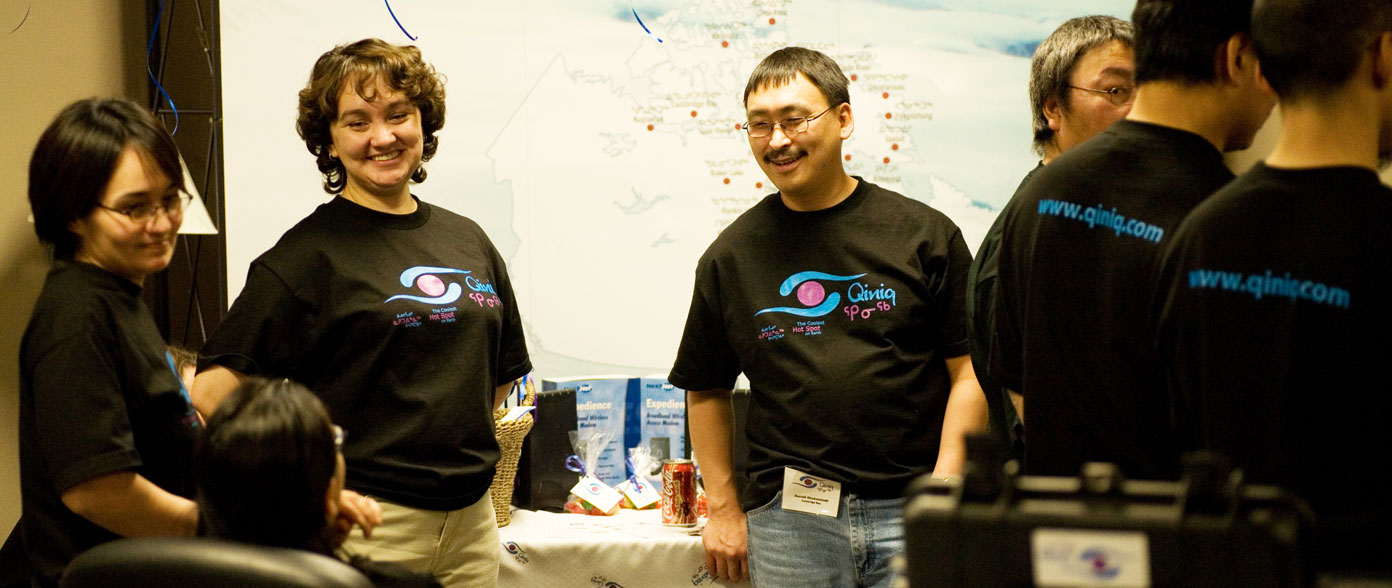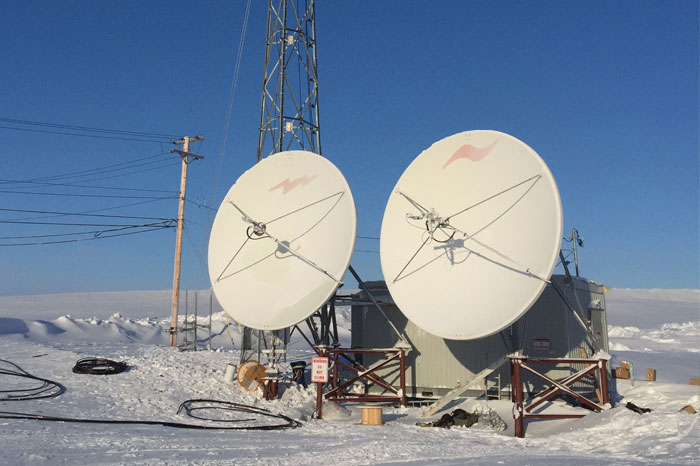QINIQ 
The Coolest Hotspot on Earth

What is QINIQ?
QINIQ means “To Search”. The QINIQ network is an advanced satellite and wireless network, delivering broadband internet services to all communities in Nunavut, Canada. The network spans 25 communities, servicing a total population of approximately 36,000 people across 2 million square kilometers.
There is no terrestrial communications infrastructure in Nunavut, and as a result, all communication with the outside world is done via satellite. The QINIQ network uses an advanced satellite platform to send and receive data in each community. The network supports full mesh connectivity, allowing any site to talk to any other site in a single satellite hop. This is critical for voice and video conferencing technologies. Dynamic bandwidth allocation is also supported, allowing the network to efficiently
allocate bandwidth where it is needed most. In order to maximize performance and reduce the impact of satellite latency, various technologies such as transparent web caches and IP accelerators are used. QINIQ’s state-of-the-art satellite infrastructure is one of the world’s most innovative broadband service solutions for remote communities. In 2016-2017, QINIQ’s wireless “last mile” was upgraded to LTE technology, creating a strong platform to deliver mobile services in Nunavut.

History
The QINIQ network is the culmination of the work of many individuals and organizations who have labored for years to make the QINIQ network a reality. QINIQ itself was largely conceived of and deployed by two organizations, the Nunavut Broadband Development Corporation and SSI Canada. The path to QINIQ, however, is much more complicated. Many people and organizations helped shape the ultimate design and model of this network.
In the fall of 2002, Industry Canada announced the Broadband for Rural and Northern Development (BRAND) program. This became the catalyst for the creation of Nunavut Broadband Development Corporation (NBDC), a not for profit group tasked with identifying the territory’s broadband needs. Before QINIQ’s launch, people in most of the territory’s 25 communities were surfing the internet using snail-slow – and incredibly expensive – dial-up connections.
Sending a single digital photo could take hours and service was often unreliable. QINIQ allowed Nunavummiut to use the web for a variety of new educational and cultural purposes.
Before QINIQ’s launch people were surfing the internet using snail-slow and incredibly expensive dial-up connections.

NBDC secured BRAND financing and issued a comprehensive RFP to vendors. SSi bid and won the RFP in the spring of 2004, and the building of the QINIQ network began. One year later, QINIQ was live and customers were signing up to the first and only network in Nunavut to provide affordable broadband service to consumers in all 25 communities.
A few years later, SSi secured and matched Infrastructure Canada funding to upgrade satellite capacity in order to meet a rapid growth in customer subscriptions and an ever increasing demand for bandwidth. As well, the funding was used to develop new broadband management tools for file storage and sharing, and voice and video conferencing.
In 2009, SSi worked with industry leaders Cisco and iDirect to re-engineer the QINIQ network,
significantly improving performance through a variety of features including DVB-S2 receivers and optimized traffic shaping.
In 2012 and again in 2016, SSi won bids to Industry Canada to further upgrade the network, add more satellite capacity, and increase speeds and usage caps for Nunavut residents. In each case, SSi matched the federal contributions. The most recent upgrade involved the installation of LTE technology. For more information on QINIQ’s growth over the years, see Ongoing Investment. qiniq.com/ongoing-investment/
Learn more about our northern roots and discover our secret to success!

The Technology
QINIQ uses state-of-the-art LTE wireless technology for “last mile” communications, featuring SIM card activated Internet modems and mobile devices that will roam in any community on the QINIQ network. This technology supports mobile voice and data, as well as telemetry solutions such as remote-monitoring security and smart metering systems. Connectivity is robust enough to support content streaming and HD videoconferencing sessions. The wireless technology is portable and non-invasive for both commercial and residential customers, easy to install and use, with no external cabling or antennas required. The network also operates within a licensed frequency range, meaning that the possibility for interference is minimized, and greater broadcast power can be used (improving signal strength and coverage).
The QINIQ network is managed by SSi Canada, a long-time Northern communications provider. SSi maintains the satellite infrastructure, the wireless last mile, all back-end hardware and the billing and management systems. QINIQ services are offered via this website and in each of the 25 Nunavut communities by a Community Service Provider (CSP), a local resident who has been selected to deliver customer services. Read more on the CSP model and its’ benefits.
The wireless technology is portable and non-invasive, easy to install and use, with no external cabling or antennas required.

The CSP model
Delivering broadband services in Nunavut comes with some unique challenges. Most Northern communities are isolated with limited accessibility.
In the winter months the weather is inhospitable and unpredictable making both freight and travel difficult. We wanted to deliver a higher level of service where customers could set up their account and jump online the same day. Providing services at a local level was an important initiative for QINIQ. To succeed, we needed to find agents directly in each community.
Providing service at a local level has always been vital to QINIQ’s success.
This special team of QINIQ representatives are known as Community Service Providers (CSPs). The CSP is a local resident that signs up accounts, takes payments and provides technical support to clients in their community. They are essential when it comes to the success of the QINIQ Network. Through the CSP we are able to connect with our customer on a local level offering them instant access to services and support.
Our CSPs have a wide range of backgrounds but they all have one thing in common. They believe in the service and they work hard to make it successful. We support one another with the aim to continue improving and meeting the technological needs of each community. Many of our service providers have been involved in these networks from day one. They are an integral part of the QINIQ team!
Did you know?
- QINIQ puts over $1.5M back into the Nunavut economy every year.
- CSPs receive a percentage of revenue each month, based on their customer base.
- Ongoing training is provided to all CSPs.
- Customers have the convenience of local service.
- CSPs manage local accounts using a custom designed billing and management system.
- To become a CSP, a person must have a solid reputation within their community.

